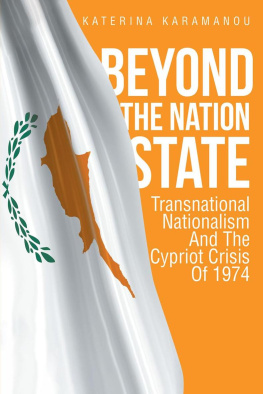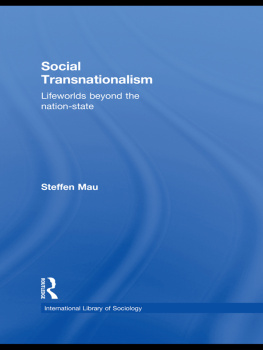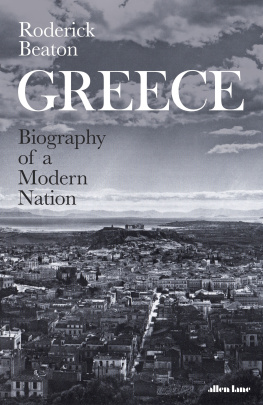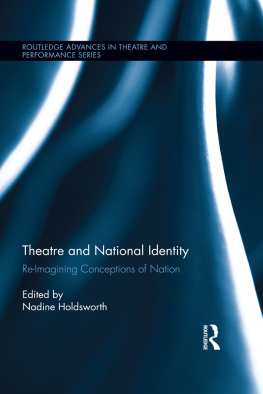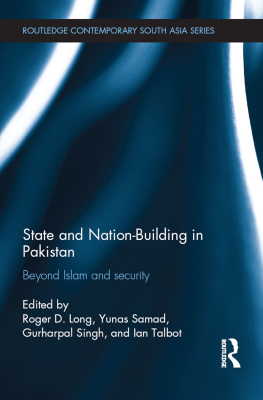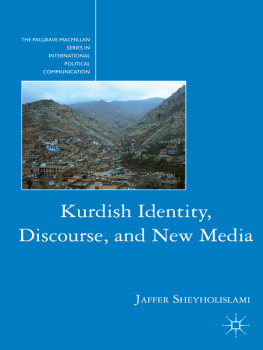Mediating the Nation:
News, Audiences and the
Politics of Identity
Mirca Madianou
First published by UCL Press
An imprint of Cavendish Publishing Limited, The Glass House, Wharton Street, London WC1X 9PX, United Kingdom
This edition published 2011 by Routledge
711 Third Avenue, New York, NY 10017, USA
2 Park Square, Milton Park, Abingdon, Oxon, OX14 4RN
Routledge is an imprint of the Taylor & Francis Group, an informa business
UCL Press 2005
All rights reserved. No part of this publication may be reproduced, stored in a retrieval system, or transmitted, in any form or by any means, electronic, mechanical, photocopying, recording, scanning or otherwise, without the prior permission in writing of Cavendish Publishing Limited, or as expressly permitted by law, or under the terms agreed with the appropriate reprographics rights organisation. Enquiries concerning reproduction outside the scope of the above should be sent to the Rights Department, Cavendish Publishing Limited, at the address above.
You must not circulate this book in any other binding or cover and you must impose the same condition on any acquirer.
British Library Cataloguing in Publication Data
Madianou, Mirca
Mediating the Nation
1. Mass media Social aspects
2. Consumption (Economics) Social aspects
3. Identity (Psychology) and mass media
4. Mass media and anthropology
I. Title 302.23
Library of Congress Cataloguing in Publication Data Data available
Hardback ISBN-10:1-84472-029-2
Hardback ISBN-13: 978-1-844-72029-3
Paperback ISBN-10:1-84472-028-4
Paperback ISBN-13: 978-1-844-72028-6
ePub ISBN-13: 978-1-136-61105-6
13579 10 8642
Typeset by Phoenix Photosetting, Chatham, Kent
Cover illustration: Zafos Xagoraris, Building with Periscopes, 1999, Private Collection
Acknowledgments
During my research and writing of this book I have been privileged to have received support from a number of people and institutions. My first debt is to all those who participated in this study but who cannot be named for obvious reasons. I want to thank them for sharing their stories and parts of their everyday lives with me. I hope that what follows does justice to their experiences and realities.
Sonia Livingstone has followed the research reported in the book from its early stages and I am extremely grateful for her encouragement and constructive criticism. Daniel Miller has been a source of inspiration with his generosity and enthusiasm. I am very thankful to Michael Worton for generous support during my Mellon fellowship at UCL, which allowed me to write the book. I would also like to thank John Thompson at the Faculty of Social and Political Sciences and the fellows of Lucy Cavendish College at the University of Cambridge who have made me feel very welcome at my new intellectual home.
Discussions with Allen Abramson, Georgie Born, Richard Collins, Nick Couldry, Nicos Demertzis, Peter Lunt, Stelios Papathanassopoulos, Andreas Onoufriou, Maggie Scammell, Eugenia Siapera, Charles Stewart and the participants of the Media@LSE research seminar in the period 19982002 have helped me shape the ideas presented in the book. I am particularly thankful to Roger Silverstone for initiating and continuing a thought provoking dialogue and to Kevin Robins and Annabelle Sreberny who provided valuable feedback as examiners of the thesis on which this book is based.
My family and friends in Athens and London have made this project possible with their emotional support and intellectual stimulation. Many thanks to Bari, Celiloglu for Turkish lessons and Zafos Xagoraris for providing the book cover. My brother George Madianos and my parents Dimitra Gefou-Madianou and Michael Madianos have been a source of invaluable support in this process to them I dedicate the book. This book is also dedicated to the memory of my friend Serafim Petrakis.
Parts of chapters 5 and 7 have appeared in the Journal of Ethnic and Migration Studies, vol 31(3).
Contents
CHAPTER 1
INTRODUCTION
On 26 April 1999, thousands of people gathered in the central square of Athens for a concert, albeit a rather unusual one. People were holding flags of all sorts: Greek flags were prominent, often tied together with Serbian ones; there were also flags symbolising the Byzantine Empire, as well as flags of the Communist Party. Some people were also holding candles and posters with anti-military and anti-American slogans. On stage paraded over sixty of Greeces artists, mainly musicians, singers and actors. In the end they all sang together under the direction of Mikis Theodorakis, a famous Greek composer and public figure. The concert, which lasted five hours, was a peace concert against the NATO bombings in Kosovo and Serbia. It was co-organised by one of the private television channels and was broadcast through live links by almost all terrestrial channels.
Images like this were common in Greece throughout the 1990s during protest marches and rallies in defence of national rights. The reader may be familiar with the large, well-attended rallies that took place during the Macedonia controversy in 1993. Television was omnipresent in these events, sometimes not only broadcasting, but also co-organising them (as happened in the case of the peace concert mentioned above). It was through the observation of such events in Greek public life that the idea for this book was born. What role did the media play in the gathering of one million people in the centres of Athens and Thessaloniki in 1993?
This book investigates the relationship between media and identities in Greece. My interest in this topic stemmed from my observations of the resurgence of nationalism in Greece in the 1990s, and the deregulation and commercialisation of the Greek broadcasting system. These two issues are related as private television channels played a central role in orchestrating and broadcasting public events, as well as adding a sensationalist touch to the reporting of national issues during that period. Moreover, the chaotic broadcasting landscape, which caused deregulation and the proliferation of channels, led to the dominance of television in Greek public life. The Greek media system is characterised by what Papathanassopoulos has described as an excess of supply over demand:
By the mid 1990s there were about 160 local, regional and national daily newspapers, as well as 800 popular and special interest magazine titles, 150 national and local television channels and 1,200 radio stations for a market of 11 million inhabitants. (1999: 381)
Television news featured prominently in the programme mix and created the phenomenon of wall to wall news. It was common for news broadcasts to last two and in exceptional circumstances up to three hours and one wonders what impact this might have had on public and everyday life.
My initial research question was whether the media, and television in particular, is a catalyst for belonging to the nation. How do viewers interpret what they see on their screens? What does it mean for their sense of nationhood? Does television provide some kind of social glue, binding people together, as the relevant literature suggests?


